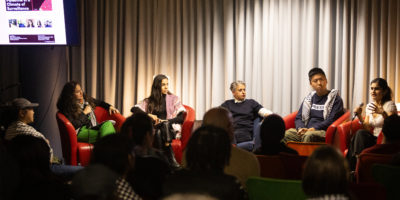By Harry Clarke
If there’s one thing Ryerson is known for, it’s our visibly creative and radical student body. Rye students have championed artistic and political freedom—from faculty-organized events like the fashion department’s annual Mass Exodus, displaying fresh fashion takes from the program’s diverse student body; to events like the Nov. 6 organized Day of Action protesting Doug Ford’s cuts to education. Similar to the student body, the independent fashion publications of Ryerson choose to define their presence with a declarative, political and culturally opinionated voice. The Eyeopener sat with four members of RADMAG and StyleCircle, the authoritative voices on fashion at Ryerson, to hear their opinions on politics, aesthetics and where the future of fashion is going.
Kaylah Wilson: Editor-in-Chief, RADMAG
How does being a part of RADmag empower you?
As a student its very inspiring to see what we do because our whole team is made up from Ryerson students of all different faculties; I’m actually from TRSM and the second of now three TRSM students that have been on the team. It’s amazing because planning the events, printing the magazine, the in-house editorials that we do-it’s very creative to see everyone working together. It’s inspiring to see us doing this, and having school and jobs on top of that.
How important do you think it is that students get a chance to express themselves creatively?
If we’re going out of 10, it’s probably a 12. Creative expression in my experience has been so amazing and even when it isn’t, it’s still beneficial. Whether you’re creatively expressing yourself through photography or planning an event, it’s so gratifying to be a part of something, see the end result and say ‘that’s my work.’ It’s empowering to be able to share stories and people’s work because it’s an important opportunity for people to feel like they’re making good work that deserves a voice.
What do you like most about fashion journalism and culture publications today?
I think the stories being told are really vital and the voices that are being told in those stories are improving the culture and the industry. You’re hearing more from people of colour or women in predominantly male industries or men in a predominantly female space, or non-binary experiences. There’s definitely more voice in creative media that wasn’t necessarily there before.
What do you feel the fashion industry needs more or less of?
More accessibility would be cool, I think creative industries can tend to build themselves into being very exclusive. Even though these big publications will be preaching all these things about inclusivity and diversity, and that’s all great, but how are you providing access to the work that you do to the people that are interested in it but can’t get there. How are they making themselves accessible to younger, diverse people?
How does RADmag set itself apart from magazine publications that came before it?
We’re journalistic in the way that we let people send things in and describe their work, but I think what sets us apart is that we will ask for your work and we will literally do nothing to it except for edit spelling mistakes; then we just put it in the magazine. We wouldn’t edit anyone’s photos because they must’ve made these choices for a reason. We let people communicate who they are in an unfiltered way. At least from what I’ve seen around Toronto, a lot of publications are very curated. We don’t really get hung up on whether we personally like it or not; if it’s good work, why not share it?
How do you personally stay inspired?
If I’m trying to get creative juices flowing, probably music. I feel very strongly about music, I love a little bit of everything. Recently I’ve been very into album covers; they say so much!
Amelia Ball: Publisher, RADmag
In what ways does working for RADmag empower you?
I think a big aspect of the way I like to do things is that I just have to do it, because if I even start to think I may not be qualified, I lose it. Being in this club and having the ability to experiment, because at the end of the day if I make a mistake it’s not the end of the world.
What are some objectives that you seek to reflect in RADmag?
First and foremost—the talent that Ryerson has. We at RADmag are a pillar for the creative community at Ryerson University. I also try to celebrate the fact that we’re all taking risks within the team and the content we create, the guts that it takes to put your work out there; it’s so scary. I try to do that in every aspect of RADmag and just saying ‘keep going’ and ‘keep putting your best self out there.’
What do you want to see more of in the fashion industry?
I feel we need to be more aware of how boring the fashion industry can be. In the way Netflix has disrupted the huge cable network, I feel like independent magazines and zines need to disrupt huge publications. I want to see different faces, I want to see more of what social justice issues look like within fashion. Where is that in Vogue? Where is that in In Style magazine? There are so many issues still left to address in fashion like gender ambiguity and clothing for people with disabilities. We’re almost in 2020–let’s do something different.
How does RADmag differ from other publications?
We’re very visual. Relying on student submissions has given us the freedom to say ‘we’re providing a platform; here’s what our amazing students do.’ We produce really high quality content too, students submit really good stuff, so much so that you could put RADmag next to an i-D or Wonderland magazine.
What things keep you fashionable?
I came to terms with thinking of my style as being a French girl who skateboards. So I like the idea of simplicity and basics but also throwing a pair of vans on or ripped denim. I’m also from B.C. and I feel there’s a big aspect of that culture that plays into things. I love street style, my phone is full of pictures and of people walking down the street. I’m also very inspired by menswear.
Do you think fashion journalism today is more socially important than in previous years?
I think there’s more platforms which means more opportunity. People are able to make fashion blogs, there are fashion influencers; digital media has been a huge disruptor and an enabler of ideas in that way. It also helps us to have critical conversations surrounding fashion, like speaking with your dollars and knowing who you’re actually supporting.
Sam Cass and Steven Nguyen: Art directors of web and print, respectively, StyleCircle
How does StyleCircle set itself apart from magazines before it and those who accompany it?
Steve: With this particular issue, I think we took a more punk stance in terms of critiquing, analyzing, questioning the industry. One of the biggest issues in the arts community is that people are really afraid to make a stance on what they define as ‘wrong,’the politics of it is everyone saying good things, which is great for reinforcing social progression. But it gets to the point where we can’t just talk about positive things and we need to look at the consequences of things.
Sam: A lot of what we do is extensive research and speaking from a respectful critique. We’re really encouraging the team to really challenge some topics and through that I think we’re returning a bit of humanity to the modern magazine.
How important do you find it is to center humanity within the fashion industry?
Steve: Fashion is essentially a reflection of society and gives cues about what may happen in the future. It’s a form of communication and is the way we live. Reinforcing the humanity aspect of fashion can inspire people to have insightful reactions towards society and culture.
Sam: I feel the aspect allows everyone to connect with the magazine. When people hear fashion they think ‘exclusivity,’ and while it can be exclusive, frivolous and fun, I think that if we’re trying to connect with our audience we need to bridge the gap that says fashion can’t be deeper.
Steve: Everyone’s a part of fashion in some way shape or form. It’s important to not just look at frivolousness but more of how our everyday lives are influenced by fashion. We’re not saving the world, per say, but we’re engaging dialogue and giving people a platform to respond.
What objectives does StyleCircle commit itself to?
Sam: We want to connect students who have a vision of something they want to create with a professional platform so that they can access the industry and showcase their work; interacting in a different way than they can on their own. If you mention StyleCircle, people in the industry will know what you’re talking about. I think it’s an enriching opportunity for people who are still learning.
Steve: Giving a sense of opportunity. You don’t necessarily have to be in fashion to participate in fashion, a lot of people on our team are in journalism, English or creative industries who want to dive into the fashion spectrum. In a way this expands the isolating part of fashion and creates a new dialogue in disrupting the traditional notions of what fashion is or who the ideal fashion worker is. We wanted to have a very inclusive community, participating in fashion should be a form of hope through getting together and collaborating.
Sam: It’s cool to see everyone get engaged and become really passionate, it’s totally leave your ego at the door kind of situation.
How do you see fashion journalism’s cultural importance growing?
Steve: Before joining StyleCircle I asked people what they wanted to see more of in magazines and 75 per cent said they wanted to see how fashion is portrayed in more of a critical eye. Fashion journalism is translated in a very different way today, most often seen in translated through social media prevalence.
What are you hoping to see more or less of in the future of the fashion industry?
Sam: I’m excited to see more people understand fashion in a political sense, in the world we live in people are engaging with fashion in such a political way. We’re starting to understand intersectionality and minority groups and how their experiences link with politics and to me fashion comes so much to the surface of that. When we think about fashion critically it can be very revealing about the way we’re moving culturally.
Steve: From a consumerist stance, I want to see buying less and investing more in pieces that resonate with you. People should put a little bit more thought into what they purchase.
Sam: One thing I’ve been having to do lately is to make space in my brain by having basics I can go to so I’m not making a decision every single morning. Then when I do want to try something different, I have the opportunity to go all out. Things like Pinterest and saving things on Instagram was such a powerful tool for me to create an aesthetic for myself.
Steve: I feed off of other people, I’m kind of like a human leech. The more I hang out with people the more I notice their attitude and their style and aesthetics and I like to see what they’re doing. A lot of people also know me as the colorful person who wears a lot of bright, bold prints and colors; it comes from a very personal point of view as it acts as a vehicle for me to be more comfortable interacting in the public eye.
Responses have been edited for length and clarity.











Kat
I think this is nice that they encourage their students to speak up on their own views. It’s cool to see them engage in this part of fashion. What a great cause.